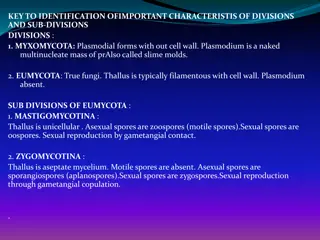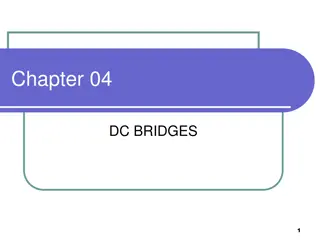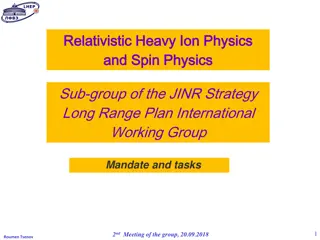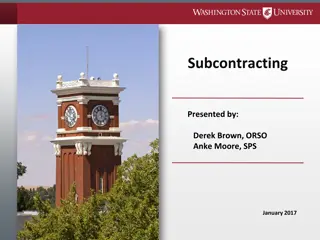
Sub-Kelvin Cryogenic Cooling and Refrigeration Methods
Discover the fascinating world of sub-Kelvin temperatures and cryogenic cooling techniques using liquid helium. Learn about the production of ultra-low temperatures through evaporation cooling and dilution refrigeration with a special focus on A3He/4He dilution refrigerators. Explore the unique properties of liquid helium, superfluidity, and the process of pumping cryogenic liquids under reduced pressure to achieve temperatures as low as 0.3 K. Dive into the science behind cryogens boiling under reduced pressure and the innovative technology of dilution refrigerators in achieving continuous cooling to temperatures as low as 2mK.
Download Presentation

Please find below an Image/Link to download the presentation.
The content on the website is provided AS IS for your information and personal use only. It may not be sold, licensed, or shared on other websites without obtaining consent from the author. If you encounter any issues during the download, it is possible that the publisher has removed the file from their server.
You are allowed to download the files provided on this website for personal or commercial use, subject to the condition that they are used lawfully. All files are the property of their respective owners.
The content on the website is provided AS IS for your information and personal use only. It may not be sold, licensed, or shared on other websites without obtaining consent from the author.
E N D
Presentation Transcript
PRODUCTION OF SUB-KELVIN TEMPERATURES:
Special properties of liquid Helium: Super fluidity: https://youtu.be/-7PNacL4n8g Note: Watch this video completely before going further.
Cryogens boiling under reduced pressure(evaporation cooling): A technique for production of temperatures lower than normal boiling point of a cryo liquid is to boil it under reduced pressure. As is well known, a liquid boils when its vapour pressure becomes equal to pressure of the vapour above the surface. If one pumps away atoms from the vapour phase above the boiling liquid, the most energetic atoms will leave the surface to replenish the vapour. Therefore mean energy of the liquid will fall down and it will cool. As a result boiling point of the liquid decreases when the pressure of the vapour above the boiling liquid is reduced. Hence pumping a cryo liquid under reduced pressure is a common method for production of lower temperatures. So with the use of large diffusion pumps with large pumping speeds by achieving a low pressure of the order of 2 10 2 to 10 6 Torr over liquid helium (4He) it is possible to reduce the temperature to roughly around 0.7 K to 0.8K. Since the vapour pressure of 3He is substantially higher than 4He at any given temperature, we will be able to reach a much lower temperature with a pumped 3He bath than a pumped 4He bath. A temperature of 0.3 K can be reached in this way.
A3He/4He dilution refrigerator is a cryogenic device that provides continuous cooling to temperatures as low as 2mK, with no moving parts in the low-temperature region.. The cooling power is provided by the heat of mixing of the Helium-3 and Helium-4 isotopes. The adjacent diagram is the phase diagram of a mixture of liquid helium-3 and liquid helium-4.. This tells us how the mixture behaves at different concentrations and temperatures. Let x be the fraction of 3He atoms in the 3He-4He mixture. In the figure, x is the horizontal axis. At point A:x = 0 means pure 4He. The Lambda line indicates the temperature at which superfluid transition takes place for a given x. At point B: At x = 0, the Lambda line shows that superfluid transition takes place at the temperature T = 2:2 K. At point C: x = 1 is pure 3He . At point D: The Lambda line stops at the junction. So it is not clear if pure 3He (at C) can become superfluid or not. In fact it can, at the much lower temperature of 2.5mK. Dilution cooling: B D C A
The dilution refrigerator uses a dilute solution of the rarer isotope of helium, 3He in the more abundant isotope 4He. When the concentration is small, the solute molecules (3 He ) behave very much like a gas. The volume of the gas is taken to be volume of the solution. (4 He). The pressure of the gas corresponds to the osmotic pressure. Addition of more solvent will dilute the solution. This reduces the concentration of the solute. The gas can be considered to have undergone expansion. An equivalent situation can be achieved by using a semi-permeable membrane between two solutions of different concentrations. The solute particles from the higher concentration side will migrate to the other side, resulting in expansion of the gas in the higher concentration side. If this dilution can be carried out adiabatically in a reversible manner , a cooling effect can be expected (analogous to J-T expansion cooling) . Hence we can expect that, adiabatic dilution of a solution of 3He in 4He will result in the production of lower temperature. https://youtu.be/5fGxRxdBmAg https://youtu.be/6QrRPOzawxA
Magnetic cooling: Magnetic coolingis a cooling technology based on the magneto caloric effect. This technique can be used to attain extremely low temperatures, as well as the ranges used in common refrigerators. The magneto caloric effect is a magneto-thermodynamic phenomenon in which a temperature change of a suitable material is caused by exposing the material to a changing magnetic field. This is also known by low temperature physicists as adiabatic demagnetization. https://youtu.be/uPd9vYvJoH0 https://youtu.be/uPd9vYvJoH0 Adiabatic demagnetization of paramagnetic salt: In order to reach temperatures below 0.3K , Debye and Giauque in 1926 suggested an entirely different approach. This was the method of adiabatic demagnetization of a paramagnetic salt. If a paramagnetic salt is magnetized isothermally in a strong magnetic field at 1K, insulated thermally and then demagnetized adiabatically, a reduction in temperature of the material is expected A temperature range of 1-100m? can be reached by this technique.
There are two major steps in this technique. They are: 1. Isothermal magnetization of salt at 1K and 2. Adiabatic demagnetization. In order to understand how cooling effect takes place, consider the variation of entropy of a paramagnetic specimen as a function of temperature and applied field in the range of 0K-1K. The adjacent diagram shows the scheme of variation of entropy of a paramagnetic salt as a function of temperature in the range of 0K to 1K for two different applied magnetic field cases: 1. H= 0 Gauss and 2. H=H1 not equal to zero.( usually large of the order of 10-30k Gauss.)
At low temperatures of the order of 1K, the contribution to the entropy from the random thermal motion of atoms is negligibly small in comparison with random distribution of atomic magnetic moments of the non-magnetized salt (represented by point A). This magnetic entropy is given by S=Rln(2J+1). Where R=gas constant and J is total angular momentum of the system. It is this Magnetic disorder entropy which is used for refrigeration. Isothermal magnetization: Let us suppose that the salt is magnetized isothermally at 1K. The atomic moments are aligned to a considerable extent. Leading to a reduction in entropy of the system. The entropy say falls from S1 to S2 (the point B) . On the other hand, the entropy of a non magnetized salt falls off with temperature along the curve ACO . The exact reason for this fall has two components: 1. interaction of atomic moments with lattice. 2. the interaction of atomic moments among themselves. Adiabatic demagnetization: Starting from the state B at 1K and a strong magnetic field of 10-30k Gauss let the salt be demagnetized adiabatically to zero field (H=0) . Entropy can t change since the process is adiabatic and hence specimen reaches the state represented by the point C in the figure and hence the temperature falls to T2 .
Experimental realization: The experimental arrangement for adiabatic demagnetization is as shown in the adjacent diagram. The paramagnetic salt (such as cerium magnesium nitrate. The active magnetic dipoles in this case are those of the electron shells of the paramagnetic atoms.) is taken in the form of an ellipsoid or a sphere of compressed powder. This solid is suspended inside an iron free solenoid by means of a fine thread. Helium gas is taken inside the container at a small pressure. A high magnetic field is applied to the sample and the resulting heat of magnetization is carried away to the surroundings by helium bath. The container is evacuated to a high degree of vacuum. The temperature of specimen will now be around 1K. It is now thermally isolated from the surroundings.
Now the specimen is adiabatically demagnetized. The process will be usually carried out by taking specimen and associated apparatus slowly out of the solenoid into a location where the magnetic field is zero. Consequently temperature falls. A device for measuring susceptibility of the salt is enclosed in the apparatus. By measuring susceptibility , Temperature is calculated using curie s law: ? = ????????. Salts used: The original proposed refrigerant was a paramagnetic salt, such as cerium magnesium nitrate. The active magnetic dipoles in this case are those of the electron shells of the paramagnetic atoms. Other salts used are: Gadolinium sulphate, Manganese ammonium sulphate, iron aluminum alam and chromium potassium alam. ( all with partially filled electron shells). In order that, demagnetization technique is useful , one must be able to cool other substances by this method. Also , it should be able to maintain low temperature reached constant over a period of time sufficient to carry out meaningful experiments at that temperature. To achieve these following points must be noted: 1. The specific heat of the salt should be large in order to be able to cool other materials, without the salt itself warming up considerably. 2. The heat influx to the system should be as small as possible. 3. Good thermal contact should be ensured between the salt and other materials to be cooled.
Nuclear demagnetization: NDR follows the same principles, but in this case the cooling power arises from the magnetic dipoles of the nuclei of the refrigerant atoms, rather than their electron configurations. Since these dipoles are of much smaller magnitude, they are less prone to self-alignment and have lower intrinsic minimum fields. This allows NDR to cool the nuclear spin system to very low temperatures, often 1 K or below. Unfortunately, the small magnitudes of nuclear magnetic dipoles also makes them less inclined to align to external fields. Magnetic fields of 3 tesla or greater are often needed for the initial magnetization step of NDR.






















